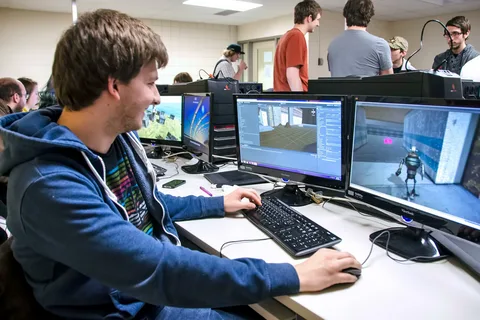Game development is a complex and expensive process, and the cost of developing a game can vary widely depending on a number of factors. Some of the most important factors that affect the cost of game development include:
- The type of game. The type of game you want to develop will have a significant impact on the cost. For example, a simple 2D mobile game will be much less expensive to develop than a complex 3D console game.
- The scope of the game. The scope of the game refers to the size, complexity, and features of the game. A game with a large number of levels, characters, and features will be more expensive to develop than a game with a smaller scope.
- The quality of the game. The quality of the game refers to the graphics, sound, gameplay, and overall polish of the game. A game with high-quality graphics and sound will be more expensive to develop than a game with lower-quality graphics and sound.
- The experience of the development team. The experience of the development team will also have a significant impact on the cost of game development. A team of experienced developers will be able to develop a game more quickly and efficiently than a team of inexperienced developers.
In addition to these factors, there are a number of other factors that can affect the cost of game development, such as the use of licensed assets, the cost of marketing and promotion, and the cost of testing and debugging.
Defining Project Scope and Requirements
Defining the project scope and requirements is a crucial first step in estimating the cost of game development. This involves clearly establishing the vision and specifications for your game. Here are the key considerations:
- Game Concept and Design:
- Establishing the game’s genre, theme, and target audience: Determine the genre of your game, whether it’s action, adventure, puzzle, simulation, etc. Identify the target audience and their preferences, as this will impact the game’s design and content.
- Outlining the gameplay mechanics and features: Define the core gameplay mechanics, such as movement, combat, puzzles, or resource management. Specify any unique or innovative features that set your game apart from others.
- Defining the visual style, art direction, and audio requirements: Decide on the visual aesthetics, whether it’s realistic, cartoonish, pixel art, etc. Consider the level of detail required in character models, environments, and animations. Determine the audio requirements, including background music, sound effects, and voice acting.
- Platform and Technology Considerations:
- Determining the target platforms: Identify the platforms on which you intend to release your game, such as PC, consoles (PlayStation, Xbox, Nintendo Switch), mobile devices (iOS, Android), or virtual reality (VR) platforms. Each platform may have different technical requirements and optimization considerations.
- Assessing the need for specialized development tools and software licenses: Consider whether you require specific game engines (Unity, Unreal Engine) or middleware for development. Evaluate the costs associated with acquiring licenses for these tools and any additional plugins or assets.
- Evaluating the level of complexity: Analyze the technical complexity of your game, including graphics requirements, physics simulation, networking capabilities, artificial intelligence, and multiplayer functionality. More complex features may require additional development time and resources.
Estimating Development Time
Estimating the development time is a crucial aspect of determining the cost of game development. Here’s a structured approach to estimating development time:
- Breaking Down Development Phases:
- Pre-production: This phase involves conceptualizing the game, creating prototypes, and documenting the design. Allocate time for brainstorming game ideas, creating concept art, building basic prototypes to test mechanics, and finalizing design documents.
- Production: This phase includes asset creation, programming, level design, and core gameplay implementation. Break down tasks such as creating character models, designing levels, coding game mechanics, implementing AI, and integrating audiovisual elements. Consider the complexity and quantity of assets required.
- Testing and Bug Fixing: Allocate time for quality assurance and debugging. This phase involves testing gameplay features, identifying and fixing bugs, and optimizing performance. Plan for multiple testing iterations to ensure a polished and bug-free experience.
- Post-production: This phase focuses on polishing, optimization, and finalization. Allocate time for enhancing graphics, refining gameplay elements, optimizing performance across different platforms, and finalizing user interfaces and menus.
- Task Estimation:
- Identify specific tasks for each development phase: Create a detailed task breakdown, considering all aspects of game development such as art production, programming, level design, audio implementation, and quality assurance.
- Assign time estimates to each task: Consider factors such as task complexity, dependencies, and the skill level of the development team. Consult with experts or experienced developers to validate your estimates. Break larger tasks into smaller sub-tasks for more accurate estimation.
- Project Management and Iterative Development:
- Allow buffer time for unforeseen delays and changes: Factor in unexpected issues, scope changes, or delays that may arise during development. It’s essential to have a contingency plan to accommodate these uncertainties.
- Incorporate agile development methodologies: Agile methodologies like Scrum or Kanban can help manage evolving requirements and adapt to changes efficiently. Use iterative development cycles, regularly reassessing and adjusting timelines based on project progress.
By breaking down development phases, estimating specific tasks, and incorporating project management strategies, you can develop a more accurate estimate of the development time. This estimation will aid in budget planning and resource allocation for your game development project.
Determining Team Size and Composition
Determining the team size and composition is a crucial step in estimating the cost of game development. Here’s a structured approach to help you with this process:
- Roles and Skillsets:
- Identifying key roles: Determine the essential roles needed for your game development team, such as game designer, programmer, artist, sound designer, writer, quality assurance tester, and project manager. Consider the specific requirements of your game project and the tasks that need to be fulfilled.
- Assessing required skillsets: Define the skillsets and expertise needed for each role. For example, a game designer should have experience in game mechanics and level design, while a programmer should be proficient in the required programming languages and technologies. Determine the necessary qualifications and experience level for each role.
Consider factors such as the complexity of your game, the desired quality level, and the scope of work when assessing the number of individuals needed for each role. More complex games with advanced features may require larger teams or specialists in specific areas.
- In-House vs. Outsourcing:
- Considering the advantages and disadvantages of in-house teams: In-house teams offer better control, direct communication, and long-term collaboration. They can foster a stronger team dynamic and provide better knowledge transfer. However, in-house teams may require higher costs for salaries, benefits, and infrastructure.
- Evaluating the cost implications of outsourcing: Outsourcing certain tasks or partnering with external development studios can provide cost savings and access to specialized expertise. Evaluate the costs of hiring freelancers, contractors, or external development studios. Consider factors such as their rates, reputation, experience, and the need for effective communication and coordination.
Determine which tasks are best suited for outsourcing, such as art production, sound design, localization, or specific technical components. Evaluate the balance between in-house resources and external support based on the project’s requirements and budget limitations.
Financial Considerations
Financial considerations are essential when estimating the cost of game development. Here’s a structured approach to help you manage the financial aspects of your project:
- Budget Allocation:
- Estimating costs for hardware, software, licenses, and development tools: Identify the hardware and software requirements for your team’s workstations, testing devices, and servers. Consider the costs of game development software, game engines, plugins, and any specialized tools or licenses needed for development.
- Allocating funds for marketing, distribution, and post-launch support: Plan for marketing and promotional activities to raise awareness and reach your target audience. Allocate funds for advertising, public relations, community management, and participation in events. Consider the costs associated with distributing the game on different platforms and any ongoing support required after the game’s launch.
- Salary and Overhead Costs:
- Calculating personnel costs, including salaries, benefits, and taxes: Determine the salaries and benefits for each team member based on their roles and experience level. Consider additional costs such as bonuses, incentives, and payroll taxes. Research industry standards or consult with experts to ensure competitive compensation.
- Factoring in office space, utilities, equipment, and other operational expenses: Account for the costs of office space, utilities (electricity, internet, water), furniture, equipment, and software licenses necessary for the development process. Include expenses for communication tools, project management software, and other operational needs.
- Contingency Planning:
- Set aside a contingency budget to account for unforeseen expenses: It’s essential to have a buffer or contingency budget to handle unexpected costs, delays, or changes in project scope. Allocate a percentage of the overall budget to cover these uncertainties.
- Plan for additional costs related to marketing, localization, or post-launch updates: Consider expenses associated with localization and translation services if you plan to target international markets. Budget for ongoing support, bug fixes, updates, and potential content expansions post-launch.
Conclusion
Estimating the cost of game development can be a complex task, but it is an essential step in the game development process. By carefully considering the factors that affect the cost of game development, you can develop a realistic budget for your game.
Here are some additional tips for estimating the cost of game development:
- Start early. The earlier you start estimating the cost of your game, the more accurate your estimate will be.
- Be realistic. Don’t underestimate the time and resources required to develop your game.
- Get feedback. Get feedback from experienced game developers on your cost estimate.
- Be flexible. The cost of game development can change over time, so be prepared to adjust your budget accordingly.
By following these tips, you can estimate the cost of game development accurately and make sure that your game is developed within budget.






